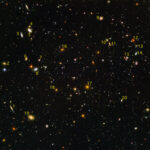The Universe contains a huge number of galaxies. By pointing our best telescopes (in this case, the Hubble Space Telescope!) at a small region of the sky and allowing for long exposure time, we can observe these galaxies and appreciate their different shapes, colors, and distribution over the sky. The Hubble Ultra Deep Field (HUDF) is a small patch of the sky that we have observed for many hours. As a result, we have a picture of exquisite depth and detail.
Laboratory Tools
For this lab all we need is this color version of the Hubble Ultra Deep Field. Click on it to open it in your browser or download it to view in the application of your choice. You’ll want to be able to zoom in so you can see the galaxies better. For a version that allows you to zoom at the full resolution of the image go here.
Assignment
The image of the Hubble Ultra Deep Field has 20 bright galaxies labeled. Label each galaxy as a regular spiral (S), barred spiral (SB), elliptical (E), or irregular (Ir). Create a data table to include in your report, then answer the questions related to galaxy statistics.
| Galaxy Label | Classification (type) |
| 1 | |
| 2 | |
| etc. |
How many spiral (regular + barred) galaxies are in this sample? How many elliptical galaxies are in this sample? Are there any obvious galactic interactions or mergers? If so, which number(s)?
Questions
- What feature is most helpful in identifying a galaxy as a spiral?
- What feature is most helpful in identifying a galaxy as an elliptical?
- Which galaxy did you have the hardest time deciding on its type and why?



